
Ley tunnel
Encyclopedia
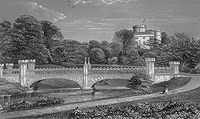
United Kingdom
The United Kingdom of Great Britain and Northern IrelandIn the United Kingdom and Dependencies, other languages have been officially recognised as legitimate autochthonous languages under the European Charter for Regional or Minority Languages...
and they also occur in Europe. In Norwegian a ley tunnel-like passage is called a "lønngang" (lønn = "hidden / secret", and gang = passage) and in Swedish a "lönngång". Ley tunnels are said to physically link together prominent places such as country houses, castles, churches, ancient monuments and other, often medieval, buildings.
Legends about the existence of ley tunnels involve usually improbably long subterranean passages, sometimes running under major obstacles such as rivers and lakes to reach their destinations. Religious buildings, monks and the landed gentry are a particularly common element in many of the ley tunnel stories.
It is unlikely that many of the recorded ley tunnels exist physically, for this is a characteristic of their very nature; their significance lies in why so many similar legends of Ley tunnels have arisen and in their connection with the more esoteric notions of channels or paths of earth energy, etc.
The origins of secret passage myths
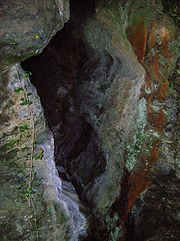
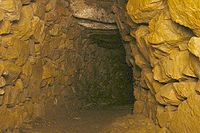
Fogou
A fogou or fougou is an underground, dry-stone structure found on Iron Age or Romano-British defended settlement sites in Cornwall. Fogous have similarities with souterrains or earth-houses of northern Europe and particularly Scotland including the Orkney Islands...
s, souterrain
Souterrain
Souterrain is a name given by archaeologists to a type of underground structure associated mainly with the Atlantic Iron Age. These structures appear to have been brought northwards from Gaul during the late Iron Age. Regional names include earth houses, fogous and Pictish houses...
s that are possibly Pict
PICT
PICT is a graphics file format introduced on the original Apple Macintosh computer as its standard metafile format. It allows the interchange of graphics , and some limited text support, between Mac applications, and was the native graphics format of QuickDraw.The original version, PICT 1, was...
ish, Roman and medieval sewers to 'smugglers' tunnels', escape tunnels, siege tunnels, and the like.
On occasion possible ley tunnels will prove to be of a purely natural origin, greatly exaggerated, such as at Cleeves Cove cave
Cleeves Cove cave
Cleeves Cove is a cave system on the Dusk Water in North Ayrshire, Scotland, close to the town of Dalry.-The cave system:Cleeves, or Cleaves, cove cave system is situated in the lower bed of carboniferous limestone. It measures around 500 feet if all the passages were put together...
in Scotland, or Kents Cavern in England. The site at Cleeves Cove cave was previously known as the 'Elfhouse' or 'Elfhame' the locals at that time believing that elves
Elf
An elf is a being of Germanic mythology. The elves were originally thought of as a race of divine beings endowed with magical powers, which they use both for the benefit and the injury of mankind...
had made it their abode.
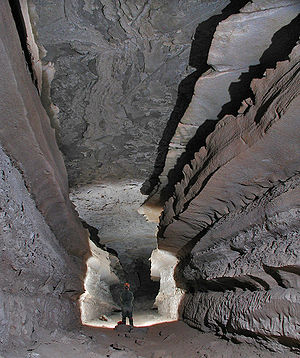
Mammoth Cave National Park
Mammoth Cave National Park is a U.S. National Park in central Kentucky, encompassing portions of Mammoth Cave, the longest cave system known in the world. The official name of the system is the Mammoth-Flint Ridge Cave System for the ridge under which the cave has formed. The park was established...
(Kentucky
Kentucky
The Commonwealth of Kentucky is a state located in the East Central United States of America. As classified by the United States Census Bureau, Kentucky is a Southern state, more specifically in the East South Central region. Kentucky is one of four U.S. states constituted as a commonwealth...
, USA
United States
The United States of America is a federal constitutional republic comprising fifty states and a federal district...
) at 591 kilometres (367.2 mi) in length, whilst the next most extensive known cave is Jewel Cave near Custer, South Dakota
Custer, South Dakota
Custer is a city in Custer County, South Dakota, United States. The population was 2,067 at the 2010 census. It is the county seat of Custer County.-History:...
, USA, at 225 kilometres (139.8 mi).
Some castles really did have escape tunnels, such as the short one located at Loudoun Castle
Loudoun Castle
Loudoun Castle is a ruined 19th century country house near Galston, in the Loudoun area of Ayrshire, Scotland. The ruins are protected as a category A listed building.-History:...
in Ayrshire, Scotland, which leads from the old kitchens to a 'tunnel-like' bridge over the Hag Burn. Others examples were longer: at Nottingham Castle
Nottingham Castle
Nottingham Castle is a castle in Nottingham, England. It is located in a commanding position on a natural promontory known as "'Castle Rock'", with cliffs high to the south and west. In the Middle Ages it was a major royal fortress and occasional royal residence...
, the young king Edward III was imprisoned by Roger de Mortimer, 1st Earl of March
Roger de Mortimer, 1st Earl of March
Roger de Mortimer, 3rd Baron Mortimer, 1st Earl of March , was an English nobleman and powerful Marcher lord, who had gained many estates in the Welsh Marches and Ireland following his advantageous marriage to the wealthy heiress Joan de Geneville, 2nd Baroness Geneville. In November 1316, he was...
. In 1330 a small group of armed supporters of Edward III used a secret passage to attack Mortimer. The attackers entered through a long, winding secret passage which led directly into the castle, allowing them to surprise and capture Mortimer.
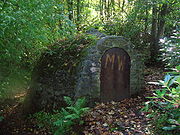
Welbeck Abbey
Welbeck Abbey near Clumber Park in North Nottinghamshire was the principal abbey of the Premonstratensian order in England and later the principal residence of the Dukes of Portland.-Monastic period:...
and Brownlow Castle; another ley tunnel type allowed for the supposed free and secret movement of monks, abbots and other ecclesiastics who may have had cause to keep a low profile for fear of attack or abusive treatment during periods of unrest, etc. Smugglers at times avoided the excise man through what are often simply just drains, sewers or water supply conduits. Some genuine smugglers' tunnels do seem to exist however.
Bruce Walker, an expert on Scottish vernacular architecture
Vernacular architecture
Vernacular architecture is a term used to categorize methods of construction which use locally available resources and traditions to address local needs and circumstances. Vernacular architecture tends to evolve over time to reflect the environmental, cultural and historical context in which it...
, has suggested that the relatively numerous and usually long ruined ice houses on country estates have led to Scotland's many legends of ley tunnels. The appearance of ice house entrances lends itself to the unitiated making such deductions, seeing as how ice houses are often found in ha-ha walls, house and stable basements, woodland banks, open fields, etc.
Many legends are associated with the actual and supposed activities of the Knights Templar
Knights Templar
The Poor Fellow-Soldiers of Christ and of the Temple of Solomon , commonly known as the Knights Templar, the Order of the Temple or simply as Templars, were among the most famous of the Western Christian military orders...
and this is a rich vein for stories about tunnels connecting together the various properties that the order used to possess up to the 12th century, when they were suppressed.
Sigmund Freud
Sigmund Freud
Sigmund Freud , born Sigismund Schlomo Freud , was an Austrian neurologist who founded the discipline of psychoanalysis...
, Jung
Jung
Carl Jung was a Swiss psychiatrist, an influential thinker and the founder of analytical psychology.Jung may also refer to:* Jung * JUNG, Java Universal Network/Graph Framework-See also:...
and others have various psychological interpretations of the symbolic meanings of tunnels and these clearly have a part to play in the origins of ley tunnel myths.
The ley line connection
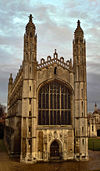
Ley line
Ley lines are alleged alignments of a number of places of geographical and historical interest, such as ancient monuments and megaliths, natural ridge-tops and water-fords...
system once existed and was very nearly lost from folk memory, saved through legends of ley tunnels, place names, etc. Ley lines may therefore be perpetuated in the legends and rumours of secret passages or ley tunnels running for considerable and unlikely distances underneath the British countryside between prominent features of the landscape. Alfred Watkins
Alfred Watkins
Alfred Watkins was a businessman, self-taught amateur archaeologist and antiquarian who, while standing on a hillside in Herefordshire, England, in 1921 experienced a revelation and noticed on the British landscape the apparent arrangement of straight lines positioned along ancient features, and...
, in The Old Straight Track
The Old Straight Track
The Old Straight Track: Its Mounds, Beacons, Moats, Sites and Mark Stones is a book by Alfred Watkins, first published in 1925, describing the existence of alleged ley lines in Britain....
, suggests that they might be connected with leys. Michael Behrend in The Landscape Geometry of Southern Britain states that the tunnel in Cambridge linking Kings College Chapel to Granchester Manor is a ley.
An example of a link between ley tunnels and ley lines has been suggested through the writings of the Rev William Beresford, Vicar of St Luke's, Leek
Leek, Staffordshire
Leek is a market town in the county of Staffordshire, England, on the River Churnet. It is an ancient borough and was granted its royal charter in 1214.It is the administrative centre for the Staffordshire Moorlands District Council...
, from 1882 to 1919. This keen antiquarian wrote about a "secret route" that went from Dieulacresse abbey in Leek, across Blackshaw Moor and ran towards Thorncliffe; this was not a true tunnel, but it was secret in that the track was sunk below ground level, allowing the monks in this instance to move about more or less hidden from the surrounding area.
Scotland

Blackness Castle
Blackness Castle is a 15th century fortress, near the village of Blackness, Scotland, on the south shore of the Firth of Forth. It was built, probably on the site of an earlier fort, by Sir George Crichton in the 1440s. At this time, Blackness was the main port serving the Royal Burgh of...
in Lothian is said to have a tunnel linking it with the House of Binns, which lies about three kilometres distant from it. A tunnel is said to run from Stanecastle
Stanecastle
Stanecastle was a medieval barony and estate in North Ayrshire, Scotland, first mentioned in 1363 and now part of the Irvine New Town project. Its nearest neighbours are Bourtreehill and Girdle Toll.-Roman origins?:...
near Irvine to Eglinton Castle
Eglinton Castle
Eglinton Castle was a large Gothic castellated mansion in Kilwinning, North Ayrshire, Scotland.-The castle :The ancient seat of the Earls of Eglinton, it is located just south of the town of Kilwinning...
and another from Stanecastle to Seagate Castle
Seagate Castle
Seagate Castle is a castle in North Ayrshire, in the town of Irvine, close to the River Irvine, Scotland. The castle was formerly a stronghold, a town house, and later a dower house of the Montgomery Clan. The castle overlooks the oldest street in Irvine, which was once the main route between the...
in Irvine, complete with a mythical piper. Monkredding
Monkredding House, North Ayrshire
Monkredding formed a small estate in the Parish of Kilwinning, North Ayrshire lying between Kilwinning and Auchentiber on the B778. The property was originally held by the Tironensian monks of Kilwinning Abbey and was the 'Monk's Garden', the rest home for the brothers. Monkcastle near Dalgarven...
was a property of Kilwinning Abbey and a tunnel is said to link the two properties. Another tunnel is said to run from Stanecastle to Dundonald
Dundonald
Dundonald is a large settlement in County Down, Northern Ireland. It lies east of Belfast and is often deemed to be a suburb of the city. It includes the large housing estate of Ballybeen, and many new housing estates have emerged in the past ten years....
. A subterranean passage was found by workmen at Stanecastle in the 19th century.
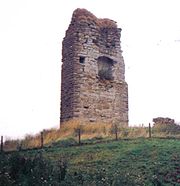
A tunnel is said to run from Loudoun Castle
Loudoun Castle
Loudoun Castle is a ruined 19th century country house near Galston, in the Loudoun area of Ayrshire, Scotland. The ruins are protected as a category A listed building.-History:...
under the River Irvine
River Irvine
The River Irvine is a river flowing through southwest Scotland, with its watershed on the Lanarkshire border of Ayrshire at an altitude of above sea-level, near Drumclog, and SW by W of Strathaven...
to Cessnock Castle in Galston, East Ayrshire
Galston, East Ayrshire
Galston is a town in East Ayrshire, Scotland which has a population of 5000 . It is situated in wooded countryside 4 miles up-river from Kilmarnock and is one a group of the small towns located in the Irvine Valley between the towns of Hurlford and Newmilns. Galston is located in the Loudoun area...
, Scotland.
A tunnel is said to run from the old Giffen Castle
Barony and Castle of Giffen
The Barony of Giffen and its associated 15th-century castle were in the parish of Beith in the former District of Cunninghame, now North Ayrshire. The site may be spelled Giffen or Giffin and lay within the Lordship of Giffin, which included the Baronies of Giffen, Trearne, Hessilhead, Broadstone,...
near Beith
Beith
Beith is a small town situated in the Garnock Valley in North Ayrshire, Scotland approximately 20-miles south-west of Glasgow. The town is situated on the crest of a hill and was known originally as the "Hill o' Beith" after its Court Hill.-History:-Name:Beith's name is thought to emanate from...
to the now abandoned farm of Bank of Giffen; some years back some children are said to have found and made their way safely through the tunnel.
A secret or Ley tunnel is said to link Old Auchans
Auchans Castle, Ayrshire
Auchans Castle, House, House of Auchans or Old Auchans, is a mock military mansion, Category A listed, T-plan building of a late 16th century date converted to the L-plan during the early-to-mid-17th century; its ruins stand about 1 km W of Dundonald, South Ayrshire, Scotland. Parish of...
and Dundonald Castle
Dundonald Castle
Dundonald Castle is situated on a hill overlooking the village of Dundonald, between Kilmarnock and Troon in South Ayrshire, Scotland. Dundonald Castle is a fortified tower house built for Robert II on his accession to the throne of Scotland in 1371 and it was used as a royal residence by the early...
. A local loch was being drained through a ditch when it was observed that the water was vanishing into the earth; locals thought that the ley tunnel had been breached.
Cleeves Cove cave
Cleeves Cove cave
Cleeves Cove is a cave system on the Dusk Water in North Ayrshire, Scotland, close to the town of Dalry.-The cave system:Cleeves, or Cleaves, cove cave system is situated in the lower bed of carboniferous limestone. It measures around 500 feet if all the passages were put together...
, the site of the Elfhame is said to be connected to Loudoun Hill and once the Laird of Auchenskeichs (sic) Collie dog entered the cave at its entrance above the Dusk Water and came out at Loudoun Hill
Loudoun Hill
Loudoun Hill, also commonly Loudounhill is a volcanic plug in East Ayrshire, Scotland. It is located near the head of the River Irvine, east of Darvel. One real and one fictional battle have been fought around Loudoun Hill.-Location:...
near Darvel
Darvel
Darvel is a small town in East Ayrshire, Scotland, located at the eastern end of the Irvine Valley and is sometimes referred to as "The Lang Toon" due to its quaint appearance on Ordnance Survey maps....
, many miles away. The end of the Cleeve Cove system is said to have never been found. Mauchline
Mauchline
Mauchline is a town in East Ayrshire, Scotland. In the 2001 census it had a recorded population of 4105. It lies by the Glasgow and South Western Railway line, 8 miles east-southeast of Kilmarnock and 11 miles northeast of Ayr. It is situated on a gentle slope about 1 mile from the River Ayr,...
Castle is said to be linked to Kingencleugh Castle by a tunnel.
A tunnel is said to run the one and a half miles from Craufurdland Castle to the Dean Castle in Kilmarnock
Kilmarnock
Kilmarnock is a large burgh in East Ayrshire, Scotland, with a population of 44,734. It is the second largest town in Ayrshire. The River Irvine runs through its eastern section, and the Kilmarnock Water passes through it, giving rise to the name 'Bank Street'...
, Ayrshire. It was used to provision the Dean Castle when it was besieged for several months in the time of Edward I and the troops only gave up when the besieged hung several freshly killed sheep over the wall and offered them to the attackers. The tunnel entrance was only blocked up in the early 19th century. Cuthbertson records the tradition of a tunnel running from Dean Castle down to the Kilmarnock Water near the old Begbie's Tavern of Burn's fame. This tunnel is said to have become a public sewer.
A local tradition was that an underground passage ran from Caldwell House
Caldwell, East Renfrewshire
Caldwell is a mansion and old estate with the remains of a castle nearby. These lands lie close to the Lugton Water and the villages of Uplawmoor in East Renfrewshire and Lugton in East Ayrshire.- Caldwell Castle and tower:...
to the old Lugton
Lugton
Lugton is a small village or hamlet in East Ayrshire, Scotland with a population of 80 people. The A736 road runs through on its way from Glasgow, to the north, to Irvine in North Ayrshire. Uplawmoor is the first settlement on this 'Lochlibo Road' to the north and Burnhouse is to the south...
Inn (now demolished), under the Lugton Water. A search by owners in the cellars did not revealed any signs of a hidden passage.

Kilwinning Abbey
Kilwinning Abbey is a ruined abbey located in the centre of the town of Kilwinning, North Ayrshire.-The establishment of the Abbey:The ancient name of the town is 'Segdoune' or 'Saigtown', probably derived from 'Sanctoun', meaning the 'town of the saint'. Saint Winnings festival was on 21 January...
, under the 'Bean Yaird', below the 'Easter Chaumers' and the 'Leddy firs', and then underneath the River Garnock and on to Eglinton Castle
Eglinton Castle
Eglinton Castle was a large Gothic castellated mansion in Kilwinning, North Ayrshire, Scotland.-The castle :The ancient seat of the Earls of Eglinton, it is located just south of the town of Kilwinning...
. No evidence exists for it, although it may be related to the underground burial vault of the Montgomeries which does exist under the old abbey or to the main sewer that would have led from the monastery to the river.

Carmunnock
Carmunnock is a conservation village within the City of Glasgow boundary, lying within three miles of East Kilbride and Rutherglen in South Lanarkshire, and Busby, East Renfrewshire....
near Glasgow
Glasgow
Glasgow is the largest city in Scotland and third most populous in the United Kingdom. The city is situated on the River Clyde in the country's west central lowlands...
a tunnel is said to have connected the parish church with dwellings used by the monks on what is now Busby Road. No sign of the tunnel has yet been found.
At Strathaven Castle
Strathaven Castle
Gavler's Castle is located in the centre of the small town of Strathaven, in South Lanarkshire, Scotland. The ruin is publicly accessible, and can be found at grid reference...
in South Lanarkshire tunnels are recorded in local tradition as running from the castle to the Sweetie's Brae, Mill Brae, and the Tower. Road works in the 19th century did not reveal anything of their existence.
A tunnel is believed to exist beneath Culross Abbey
Culross Abbey
Culross Abbey is a former Cistercian abbey in Culross, Scotland, headed by the Abbot or Commendator of Culross. It is still used as the local parish church by the Church of Scotland.-History:...
in Fife and within is said to sit a man in a golden chair waiting to give valuable treasures to anyone who succeeds in finding him. Many years ago a blind piper decided to try and upon entering at Newgate with his dog he proceeded to search and could be heard playing his pipes as far as the West Kirk, three quarters of a mile away. Eventually the dog emerged into the daylight, however the piper was never seen, or heard of, again. The caves below Keil Point on Isle of Arran
Isle of Arran
Arran or the Isle of Arran is the largest island in the Firth of Clyde, Scotland, and with an area of is the seventh largest Scottish island. It is in the unitary council area of North Ayrshire and the 2001 census had a resident population of 5,058...
contain a slab which may have been an ancient altar. It has the prints of two right feet on it, said to be of Saint Columba.
In the 19th century some women found the secret tunnel of Coupar Angus Abbey
Coupar Angus Abbey
Coupar Angus Abbey was a Cistercian monastery near Coupar Angus, in central Scotland, on the boundary between Angus and Gowrie.It was founded on the old royal manor of Coupar in 1161 x 1162 with the patronage of Máel Coluim IV , King of Scots, by Cistercian monks from Melrose Abbey...
near the entrance to the churchyard. One went in and was never seen again, however in 1982 a local mason found the entrance again and went in some distance before finding a cave in. It is said that the tunnel ran a further two and a half miles to a souterrain at Pitcur. Fingask Castle
Fingask Castle
Fingask Castle is a country house in Perth and Kinross, Scotland. It is perched above Rait, three miles north-east of Errol, in the Braes of the Carse, on the fringes of the Sidlaw Hills. Thus it overlooks both the Carse of Gowrie and the Firth of Tay and beyond into the Kingdom of Fife...
has underground passages, still partly open in 1766, said to run to Kinnaird Castle
Kinnaird Castle
Kinnaird Castle can refer to:*Kinnaird Castle, Fraserburgh, Aberdeenshire, Scotland.*Kinnaird Castle, Kinnaird, Perth & Kinross, Scotland.*Kinnaird Castle, Brechin, Angus, Scotland....
, two kilometres away. A ley tunnel is said to run under the Tay between the hospital of Seggieden and the nunnery at Elcho
Elcho
Elcho may refer to:* Earl of Wemyss* Elcho Castle Castle, village, and site of former nunnery near Perth, Scotland* Elcho Shield international match rifle competition* Elcho, Wisconsin, a town United States...
. Newton Castle in Blairgowrie
Blairgowrie
Blairgowrie is the name of several places in the world:* Blairgowrie and Rattray, United Kingdom* Blairgowrie, Victoria, Australia* Blairgowrie, Gauteng, South Africa...
is said to have a tunnel that runs to Ardblair. Ashintully Castle
Ashintully Castle
Ashintully Castle, located near Kirkmichael, north of Blairgowrie, in the county of Perthshire Scotland, was built in 1583 as a fortified tower house by the Spalding family; the Feudal Barons of Ashintully. The Spalding Barons were chiefs of the Spalding Clan and followers of the Duke of Atholl,...
in Strathadle and Glenshee has a tunnel linking it to its predecessor, Whitefield Castle. In the Weem
Weem
Weem is a village on the B846 near Aberfeldy in Perthshire, Scotland.The name Weem is derived from the Gaelic uaimh, meaning 'cave'....
area Saint David's Well is said to have a cave beneath it which connects with another cave at Loch Glassie, two kilometres away. At Monzievaird Castle in Strathearn
Strathearn
Strathearn or Strath Earn is the strath of the River Earn, in Scotland. It extends from Loch Earn in Perth and Kinross to the River Tay....
a secret tunnel is said to run from the castle to the Turret Burn.
Near Moniaive in Dumfries and Galloway a tunnel is said to have run from under the Caitloch bridge over the Dalwhat Water to Caitloch House, some distance away. The tunnel is said to have been used by Covenanters evading the King's Dragoons during those troubled days and is now blocked.
Brodick Castle
Brodick Castle
Brodick Castle is a castle situated outside the port of Brodick on the Isle of Arran, an island in the Firth of Clyde, Scotland. It was previously a seat of the Dukes of Hamilton, but is now owned by the National Trust for Scotland.-Early and High Mediæval:...
on the Isle of Arran
Isle of Arran
Arran or the Isle of Arran is the largest island in the Firth of Clyde, Scotland, and with an area of is the seventh largest Scottish island. It is in the unitary council area of North Ayrshire and the 2001 census had a resident population of 5,058...
had a tunnel which apparently ran down to the shore in Brodick Bay. Circa 1920 the duchess was renovating the castle and had a hollow sounding section of wall opened up. This work quickly ceased when a story was remembered of two plague victims in the 18th century having been walled up in an old tunnel, first having been covered in quicklime and rubble.
Gordon in 1726 records that at Ardoch
Ardoch
Ardoch Roman Fort is an archaeological site just outside the village of Braco in Perthshire, Scotland, about 7 miles south of Crieff. At Ardoch are the remains of a Roman fort and castra which included Ardoch Tower...
Roman Fort near Dunblane
Dunblane
Dunblane is a small cathedral city and former burgh north of Stirling in the Stirling council area of Scotland. The town is situated off the A9 road, on the way north to Perth. Its main landmark is Dunblane Cathedral and the Allan Water runs through the town centre, with the Cathedral and the High...
in Perth and Kinross a subterranean passage was said to run from the fort, under the River Tay, to the fort or 'Keir' on Grinnin Hill. This tunnel is said to contain a great deal of treasure as recorded in these lines;
"From the Camp of Ardoch, To the Grinnin Hill of Keir, Are nine Kings rents, For seven hundred year." |
England
At Furness AbbeyFurness Abbey
Furness Abbey, or St. Mary of Furness is a former monastery situated on the outskirts of the English town of Barrow-in-Furness, Cumbria. The abbey dates back to 1123 and was once the second wealthiest and most powerful Cistercian monastery in the country, behind only Fountains Abbey in North...
a tunnel has been said to run underneath the Abbey to both Piel Castle
Piel Castle
Piel Castle also known as Fouldry Castle, is a castle situated on the south-eastern point of Piel Island, 1 km off the southern tip of the Furness Peninsula, protecting the deep water harbour of Barrow-in-Furness in north west England.....
and Dalton Castle
Dalton Castle
Dalton Castle is a 14th-century peel tower situated in Dalton-in-Furness, Cumbria, England, and in the ownership of the National Trust. It was constructed by the monks of Furness Abbey for the protection of the nearby market town, and was the building from which the Abbot administered the area and...
. This was said to be how the monks travelled to and from each monument to receive foodstuffs and keep watch upon the towns. It has also been rumoured that the Holy Grail and King John’s missing jewels, are actually hidden somewhere inside.

Richmond Castle
Richmond Castle in Richmond, North Yorkshire, England, stands in a commanding position above the River Swale, close to the centre of the town of Richmond. It was originally called Riche Mount, 'the strong hill'...
in North Yorkshire
North Yorkshire
North Yorkshire is a non-metropolitan or shire county located in the Yorkshire and the Humber region of England, and a ceremonial county primarily in that region but partly in North East England. Created in 1974 by the Local Government Act 1972 it covers an area of , making it the largest...
standing in an impressive cliff-top position overlooking the River Swale
River Swale
The River Swale is a river in Yorkshire, England and a major tributary of the River Ure, which itself becomes the River Ouse, emptying into the North Sea via the Humber Estuary....
. A potter named Thompson is said to have discovered a tunnel entrance at the bottom of this cliff. Following it deep into the hillside, he came to a large cavern where slept King Arthur
King Arthur
King Arthur is a legendary British leader of the late 5th and early 6th centuries, who, according to Medieval histories and romances, led the defence of Britain against Saxon invaders in the early 6th century. The details of Arthur's story are mainly composed of folklore and literary invention, and...
and his knights around the famous Round Table
Round Table
The Round Table is King Arthur's famed table in the Arthurian legend, around which he and his Knights congregate. As its name suggests, it has no head, implying that everyone who sits there has equal status. The table was first described in 1155 by Wace, who relied on previous depictions of...
. On the table lay an ancient horn and a mighty sword. Thompson reached out and picked up the horn, but the sleepers began to awake and, fearing for his life, the potter fled. As he raced down the tunnel back to daylight and safety, he heard a voice behind him declare:
-
- "Potter Thompson, Potter Thompson!
- If thou hadst drawn the sword or blown the horn,
- Thou hadst been the luckiest man e'er was born."
The tunnel appears to have been well known, though the cave remains hidden. A second story tells how this subterranean passage is supposed to run from the Castle to nearby Easby Abbey
Easby Abbey
Easby Abbey or the Abbey of St Agatha is an abandoned Premonstratensian abbey on the eastern bank of the River Swale on the outskirts of Richmond in the Richmondshire district of North Yorkshire. The site is maintained by English Heritage and can be reached by a pleasant riverside walk from...
. Some soldiers once sent a drummer-boy along it to test the theory and followed the sound of his drum almost halfway to the Abbey. Then the drumming stopped! The boy was never seen alive again - but his ghost is said to haunt the tunnel from where a slow drumbeat is still sometimes heard. A memorial stone marks the spot at which the drum beat was last heard. It is believed that the legendary tunnel was constructed in medieval times as an escape route to the castle for the Abbot and Canons of the Abbey in case of an attack from the Scots, who were continually making raids into the northern counties of England.
A smugglers' tunnel is said to run from Smugglers' Farm in Herstmonceux
Herstmonceux
Herstmonceux is a village and civil parish in the Wealden District of East Sussex, England. The parish includes Herstmonceux Castle, the village of Cowbeech and a number of smaller hamlets.-History:...
, Sussex to the Pevensey
Pevensey
Pevensey is a village and civil parish in the Wealden district of East Sussex, England. The main village is located 5 miles north-east of Eastbourne, one mile inland from Pevensey Bay. The settlement of Pevensey Bay forms part of the parish.-Geography:The village of Pevensey is located on...
Marshes, a good distance away.
A whole network of secret Knights Templar tunnels are said to run beneath Hertford Castle
Hertford Castle
Hertford Castle was a Norman castle situated by the River Lea in Hertford, the county town of Hertfordshire, England.-Early history:Hertford Castle was built on a site first fortified by Edward the Elder around 911. By the time of the Norman Invasion in 1066, a motte and bailey were on the site...
, running to Dinsley and other local places.
A 'secret tunnel' exists at Pevensey Castle in East Sussex, although not open for public access - it links the keep with the former market square and is thought to be Norman in origin, although was reused during WWII.
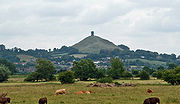
Glastonbury Tor
Glastonbury Tor is a hill at Glastonbury, Somerset, England, which features the roofless St. Michael's Tower. The site is managed by the National Trust. It has been designated as a Scheduled Ancient Monument ....
. The most famous tale is about a tunnel from Glastonbury Abbey
Glastonbury Abbey
Glastonbury Abbey was a monastery in Glastonbury, Somerset, England. The ruins are now a grade I listed building, and a Scheduled Ancient Monument and are open as a visitor attraction....
to the Tor. At one time some thirty monks are rumoured to have entered the Tor via this tunnel, but only three came out again, two insane and one struck dumb. Another legend which is widely believed is that of the long-distance tunnel leading from the crypt of the Lady (or Galilee) Chapel, under the River Brue
River Brue
The River Brue originates in the parish of Brewham in Somerset, England, and reaches the sea some 50 km west at Burnham-on-Sea. It originally took a different route from Glastonbury to the sea, but this was changed by the monastery in the twelfth century....
to a distant point, possibly to the village of Street, where a passage exists from an outlying building in the grounds of the old manor house. A dog is said to have been put into the tunnel at Street and found his way out at the Glastonbury end.
A tunnel is said to run from King's College Chapel to Granchester Manor, Cambridge
Cambridge
The city of Cambridge is a university town and the administrative centre of the county of Cambridgeshire, England. It lies in East Anglia about north of London. Cambridge is at the heart of the high-technology centre known as Silicon Fen – a play on Silicon Valley and the fens surrounding the...
, passing under the river Cam.
Evidence of tunnels have recently been found beneath Saint Luke's, Leek's old church, reinforcing legends of a ley tunnel running from the church to Dieulacresse abbey.
A tunnel is said to run from Newbury
Newbury, Berkshire
Newbury is a civil parish and the principal town in the west of the county of Berkshire in England. It is situated on the River Kennet and the Kennet and Avon Canal, and has a town centre containing many 17th century buildings. Newbury is best known for its racecourse and the adjoining former USAF...
Town Hall to St Nicolas Church. This belief may have started because there are east west flowing brick victorian service tunnels running from roughly the Newbury arcade towards this church; these were exposed to the public's gaze during construction work. A tunnel is also said to run from Newbury Castle
Newbury Castle
Newbury Castle is the name of an English adulterine castle built by John Marshal during The Anarchy. The Castle is mentioned in the "L'Histoire de Guillaume le Marechal" wherein it describes King Stephen as besieging the castle in 1152 and holding Marshal's son, William Marshal, as a hostage...
(400 ft above sea level) and Shaw House (260 ft, thus 140 ft below it). The point of entry is said to be hollow space (now blocked) in the south-east angle of the enclosure. In 1930 workmen investigated the legend by excavations of the entrance, but found nothing.
At Necton
Necton
Necton, commonly called Neeton, is a village situated on a turning off the A47 main road between Swaffham and East Dereham in the Breckland district of mid-Norfolk. As at the 2001 census it has a population of 1,865 residents and an area of...
in East Anglia a tunnel is said to run from the restored 14th century church of All Saints to Necton Hall, in possession of the Mason family since the time of Henry VII.
.jpg)
Norwich
Norwich is a city in England. It is the regional administrative centre and county town of Norfolk. During the 11th century, Norwich was the largest city in England after London, and one of the most important places in the kingdom...
leads from the Castle (TM232085) to the Guildhall (TM231085) near the market-place, erected 1407 - 13 on the site of the old tollhouse. It still has a 14th century vault below it, that was the crypt (and prison) of the former building. A second tunnel (in which a pig was once lost) heads from the Castle for Carrow Priory (TM242073 area), a Benedictine nunnery whose scant 12th century remains on the outskirts of Norwich are incorporated into a residence of the Colman family, near the junction of King Street and Bracondale. The third tunnel from the Castle ran to the Norman cathedral to the north-east (TM235089), begun in 1096 by Bishop Herbert de Losinga, and finally consecrated in 1101 - 2. Yet another subterranean way links the Castle with the Crown Derby near the Guildhall.

Norwich Cathedral
Norwich Cathedral is a cathedral located in Norwich, Norfolk, dedicated to the Holy and Undivided Trinity. Formerly a Catholic church, it has belonged to the Church of England since the English Reformation....
another tunnel begins, running for about nine miles to the ruins of St. Benet's Abbey (TG383157) on the marshes at Ludham
Ludham
Ludham is a village and civil parish in the English county of Norfolk, in The Broads, at the end of a dyke leading to Womack Water and flowing into the River Thurne...
. A much shorter one, allegedly used by monks, was said to run from the cathedral to Samson & Hercules House. The Anglia Restaurant in Prince's Street has a splendid groined crypt for a cellar, and two tunnels from here are said to lead to the cathedral, and to St. Andrew's Hall. Monks supposedly used a tunnel from the cellars of the Shrub House at the corner of Charing Cross Street, to the site of St. Benedict's Gates.
In early January 1644, Cromwell sent his forces to Norwich
Norwich
Norwich is a city in England. It is the regional administrative centre and county town of Norfolk. During the 11th century, Norwich was the largest city in England after London, and one of the most important places in the kingdom...
to demand the surrender of a small group of Royalists, whom he heard to be presently at the Maid's Head Hotel. According to legend, as the Parliamentarians entered the hotel, the Royalists retreated through a secret tunnel, stretching steel ropes across the way behind them. Many of Cromwell's men (and their horses) were beheaded as they raced through the tunnel in pursuit, and this incident is used to explain the sound of ghostly hoofbeats often heard emanating from under the ground around the Cathedral Close.

Bournemouth
Bournemouth is a large coastal resort town in the ceremonial county of Dorset, England. According to the 2001 Census the town has a population of 163,444, making it the largest settlement in Dorset. It is also the largest settlement between Southampton and Plymouth...
suburb, to the coast some four miles away.
In the 19th century, it was said that an underground passage ran from the remains of the 12th century Gisborough Priory
Gisborough Priory
Gisborough Priory is a ruined former Augustinian priory in the town of Guisborough, now in the borough of Redcar and Cleveland and the ceremonial county of North Yorkshire, England. It was founded in 1119 as the Priory of St. Mary by Robert de Brus, 1st Lord of Annandale, an ancestor of the...
, immediately south of Guisborough parish church, to a field that lay in the parish of Tocketts. Halfway along was said to be a chest of gold guarded by a raven or crow. In Cleveland almost every old castle and ruined monastery has its legend of a subterranean passage leading therefrom, which someone has penetrated to a certain distance, and has seen an iron chest, supposed to be full of gold, on which was perched a raven. The raven may suggest a Scandinavian origin of the legends.
sep2004.jpg)
Bracknell
Bracknell is a town and civil parish in the Borough of Bracknell Forest in Berkshire, England. It lies to the south-east of Reading, southwest of Windsor and west of central London...
's Old Manor is a beautiful 17th century brick manor house complete with priest hole
Priest hole
"Priest hole" is the term given to hiding places for priests built into many of the principal Catholic houses of England during the period when Catholics were persecuted by law in England, from the beginning of the reign of Queen Elizabeth I in 1558....
. It is said to have secret passages connecting to various locations.
Droitwich Spa
Droitwich Spa
Droitwich Spa is a town in northern Worcestershire, England, on the River Salwarpe.The town is situated on massive deposits of salt, and salt has been extracted there since ancient times. The natural Droitwich brine contains 2½ lbs...
is said to have a passageway that leads from St Augustine’s church, Dodderhill, to Friar Street in the town centre. A system of tunnels is said to run from there to St Augustine’s and St Andrew’s churches.
The story that Thomas a Becket from Northampton Castle
Northampton Castle
Northampton Castle was built under the stewardship of Simon de Senlis, the first Earl of Northampton, in 1084. It took several years to complete, as there is no mention of it in the Domesday Book, a great survey of England completed in 1086....
is a well documented part of 12th century history but how the persecuted Archbishop of Canterbury managed to flee from the fortress remains a mystery. One myth is that he fled from the clutches of Henry II through a tunnel that linked the castle to All Saints Church in Mercers Row.
At Binham Priory
Binham Priory
St Mary's Priory, Binham, or Binham Priory, is a ruined Benedictine priory located in the village of Binham in the English county of Norfolk. Today the nave of the much larger priory church has become the Church of St. Mary and the Holy Cross and is still used as a place of worship...
in Norfolk a fiddler entered the tunnel which ran beneath the building and could be heard for some distance before suddenly ceasing. The fiddler was never seen again.
The rhyme below dates from the 17th century and recalls the tradition that a tunnel connects what is now Syon House
Syon House
Syon House, with its 200-acre park, is situated in west London, England. It belongs to the Duke of Northumberland and is now his family's London residence...
with the friary of Sheen
Sheen
Sheen could mean:Places:*In south west London, England:** Sheen or West Sheen, an alternative name for Richmond, London** East Sheen** North Sheen** Sheen Priory* Sheen, Staffordshire, United Kingdom...
at Richmond in Surrey, a considerable distance away.
-
- "The Nun of Sion, with the Friar of Shean,
- Went under water to play the Quean."
The origin of the legend remains a mystery.
In Leicestershire a subterranean passage is said to connect a nunnery which once stood near the Humber Stone with Leicester Abbey
Leicester Abbey
Leicester Abbey, the Abbey of Saint Mary de Pratis , standing about a mile north of the city of Leicester in the riverside meadows on the west bank of the River Soar, was built under the patronage of Robert le Bossu, Earl of Leicester. It was founded as a community of Augustinian Canons, the...
. In the cellars under Leicester Castle
Leicester Castle
Leicester Castle is located in the city of the same name in the English county of Leicestershire. The complex is situated in the west of the city centre, between Saint Nicholas Circle to the north and De Montfort University to the south....
a witch known as 'Black' or 'Cat Anna' is said to have lived. She is said to have journeyed to the Dane Hills
Dane Hills
Dane Hills is a large area on the western side of the English city of Leicester,consisting of the smaller areas of Newfoundpool, Western Park, and New Parks, which is bounded by Glenfield to the west. A cave in this area was known as Black Annis's Bower, the cave being reputed to be the lair of a...
through an underground passage.
Wales
Local legend states that a tunnel connects the now ruined Court FarmCourt Farm, Pembrey
Court Farm in Pembrey, Carmarthenshire, Wales, is an ancient and formerly imposing manor house which is now an overgrown ruin, but structurally sound, and capable of repair and restoration...
with the nearby church in Pembrey
Pembrey
Pembrey is a village in Carmarthenshire Wales, situated between Burry Port and Kidwelly, overlooking Carmarthen Bay.-History:The name Pembrey is an Anglicisation of the Welsh, Pen-bre...
, South Wales.
Ireland
In LurganLurgan
Lurgan is a town in County Armagh, Northern Ireland. The town is near the southern shore of Lough Neagh and in the north-eastern corner of the county. Part of the Craigavon Borough Council area, Lurgan is about 18 miles south-west of Belfast and is linked to the city by both the M1 motorway...
a tunnel supposedly went from Brownlow House to the local police station, the courthouse and to the church in the middle of the town. Another tunnel was from Soyes Mill to Lurgan Castle. One explanantion for the Brownlow tunnel was that Lord Brownlow had a very over protective wife, and after many years of a good marriage, things went sour, so Brownlow had this Tunnel dug so he would be able to exit the castle after dark without his wife finding out. Once out, he would go on the hunt for some Lurgan lassies, Book a room at the Ashburn Hotel, then leave early in the morning to get back in time for breakfast at the castle with the wife. Lakafinna, to the South of Bullaun
Bullaun
A bullaun is the term used for the depression in a stone which is often water filled. Natural rounded boulders or pebbles may sit in the bullaun...
, has a castle and local folklore relates that a tunnel exists between this castle and the village of Ballyara.
Denmark
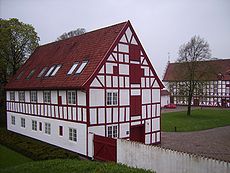
Aalborg
-Transport:On the north side of the Limfjord is Nørresundby, which is connected to Aalborg by a road bridge Limfjordsbroen, an iron railway bridge Jernbanebroen over Limfjorden, as well as a motorway tunnel running under the Limfjord Limfjordstunnelen....
a tunnel is said to have run from the convent under the fjord to another convent near Sundby. This tunnel had branches which ran to an old bridge, two churches and to the castle of Aalborghus. A student once tried to explore the tunnels with a long cord, a sword and a light. The broken cord was retrieved, but the student was never seen again.
Ukraine
A mysterious tunnel is said to run to Kniazh Hill that was used during emergencies by the Semashko Princes and the other owners of Gubkiv Castle, the powerful princes Danylovych. This tunnel, it is said, starts near the deep well in the castle yard.Subterranean passages
Ley tunnels differ from most of the numerous examples of actual secret passages and the like in that Ley tunnels are usually very long. Many examples of extensive underground passages do actually exist, built for a variety of purposes, however they often lack the link with churches, aristocracy, etc and do not necessarily involve prominent buildings.An exception is the Ley tunnel that is said to run from the 'bottomless' Saint Michael's Cave in Gibraltar
Gibraltar
Gibraltar is a British overseas territory located on the southern end of the Iberian Peninsula at the entrance of the Mediterranean. A peninsula with an area of , it has a northern border with Andalusia, Spain. The Rock of Gibraltar is the major landmark of the region...
under the Strait of Gibraltar
Strait of Gibraltar
The Strait of Gibraltar is a narrow strait that connects the Atlantic Ocean to the Mediterranean Sea and separates Spain in Europe from Morocco in Africa. The name comes from Gibraltar, which in turn originates from the Arabic Jebel Tariq , albeit the Arab name for the Strait is Bab el-Zakat or...
, exiting in Morocco
Morocco
Morocco , officially the Kingdom of Morocco , is a country located in North Africa. It has a population of more than 32 million and an area of 710,850 km², and also primarily administers the disputed region of the Western Sahara...
, Africa.
Drains, sewers and water supplies

An example of a medieval building with many subterranean passages is Prague Castle
Prague Castle
Prague Castle is a castle in Prague where the Kings of Bohemia, Holy Roman Emperors and presidents of Czechoslovakia and the Czech Republic have had their offices. The Czech Crown Jewels are kept here...
. In the Middle Ages underground passages were dug out mainly for purposes of defence and later drainage conduits sufficed to take the waste waters to the foot of the castle wall and then let it fall freely over the slope of the bare cliff face into the bed of the Brusnice stream. The inhabitants of the Castle complained of the smell of the slope, so two conduits were built as far as the Brusnice stream. One leads from Hradcany Square and the other, known as the castle passage, from the second Castle courtyard to the bottom of the Deer Moat.

Paisley Abbey
Paisley Abbey is a former Cluniac monastery, and current Church of Scotland parish kirk, located on the east bank of the White Cart Water in the centre of the town of Paisley, Renfrewshire, in west central Scotland.-History:...
in Scotland, few of the original monastic buildings survived into the 20th century, so landscaping of the area around the church in 1990 provided the ideal opportunity to investigate the positions of those now "lost". The main drain, which would have brought fresh water into the complex, and taken away the effluents, would have acted as the spinal column of the buildings. Local knowledge led to the rediscovery of a substantial medieval drain with fine stonework and enough space for a person to walk through.
In Exeter
Exeter
Exeter is a historic city in Devon, England. It lies within the ceremonial county of Devon, of which it is the county town as well as the home of Devon County Council. Currently the administrative area has the status of a non-metropolitan district, and is therefore under the administration of the...
, South Devon, medieval tunnels dating from the 14th century under the High Street are a unique ancient monument. The tunnels were built to house the pipes that brought fresh water to the city. These Underground Passages have long exercised a fascination over local people, bringing stories of buried treasure, secret escape routes, passages for nuns and priests - even a ghost on a bicycle. Their purpose was simple: to bring clean drinking water from natural springs in fields lying outside the walled city, through lead pipes into the heart of the city.
Siege mines or tunnels

St Andrews
St Andrews is a university town and former royal burgh on the east coast of Fife in Scotland. The town is named after Saint Andrew the Apostle.St Andrews has a population of 16,680, making this the fifth largest settlement in Fife....
in Scotland. Cardinal Beaton in March 1546, had the Protestant preacher, George Wishart, burnt at the stake in front of his castle walls and this was subsequently used as a pretext for Beaton's murder at the hands of local Protestant lairds who captured the castle by stealth. A long siege followed on the orders of the Regent, the Earl of Arran, however by November 1546 this had resulted in a stalemate. A determined effort to undermine the walls of the castle via a spacious tunnel large enough to take pack animals was intercepted, after several false starts, by the defenders. They dug a low, narrow and twisting countermine through the rock that eventually broke into the mine itself.
Escape tunnels
Many medieval buildings are said to have had escape tunnels, secret by nature and hence likely to be the stuff of myth, legend and exaggeration. One example is the escape tunnel running from Maynooth Castle has its exit at the tower in Laraghbryan. A short escape tunnel has been located at Loudoun CastleLoudoun Castle
Loudoun Castle is a ruined 19th century country house near Galston, in the Loudoun area of Ayrshire, Scotland. The ruins are protected as a category A listed building.-History:...
in Ayrshire, Scotland, which leads from the old kitchens to a 'tunnel-like' bridge over a burn. Other escape tunnels were longer, such as at Nottingham Castle
Nottingham Castle
Nottingham Castle is a castle in Nottingham, England. It is located in a commanding position on a natural promontory known as "'Castle Rock'", with cliffs high to the south and west. In the Middle Ages it was a major royal fortress and occasional royal residence...
, where the young king Edward III was imprisoned by Roger de Mortimer, 1st Earl of March
Roger de Mortimer, 1st Earl of March
Roger de Mortimer, 3rd Baron Mortimer, 1st Earl of March , was an English nobleman and powerful Marcher lord, who had gained many estates in the Welsh Marches and Ireland following his advantageous marriage to the wealthy heiress Joan de Geneville, 2nd Baroness Geneville. In November 1316, he was...
. In 1330 a small group of armed supporters of Edward III used a secret passage to attack Mortimer. The attackers entered through a long, winding secret passage which led directly into the castle, allowing them to surprise and capture Mortimer, releasing the king who was unharmed.
Smugglers' tunnels

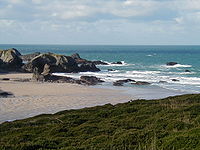
Some tunnel stories turn out to be very plausible, such as the tunnel at Hayle
Hayle
Hayle is a small town, civil parish and cargo port in west Cornwall, United Kingdom. It is situated at the mouth of the Hayle River and is approximately seven miles northeast of Penzance...
in Cornwall which really does seem to have been built specifically for smuggling. In other instances the tunnel either doubles as a storm drain or some other functional channel, or else is an extension of a natural fissure in the rock, as at Methleigh and Porthcothan
Porthcothan
Porthcothan is a coastal village in Cornwall, United Kingdom, situated between Newquay and Padstow. It is within the parish of St Eval. The beach is popular with tourists and surfers and is patrolled by lifeguards during the day in the summer; local surf schools sometimes use the beach for tuition...
respectively.
Beith
Beith
Beith is a small town situated in the Garnock Valley in North Ayrshire, Scotland approximately 20-miles south-west of Glasgow. The town is situated on the crest of a hill and was known originally as the "Hill o' Beith" after its Court Hill.-History:-Name:Beith's name is thought to emanate from...
in North Ayrshire
North Ayrshire
North Ayrshire is one of 32 council areas in Scotland with a population of roughly 136,000 people. It is located in the south-west region of Scotland, and borders the areas of Inverclyde to the north, Renfrewshire to the north-east and East Ayrshire and South Ayrshire to the East and South...
was a notorious haunt of smugglers at one time, and legend has it that a tunnel ran from the town centre down to Kilbirnie Loch
Kilbirnie Loch
Kilbirnie Loch , is situated in the floodplain of between Kilbirnie, Glengarnock and Beith, and runs south-west to north-east for almost , is about wide for the most part and has an area of roughly 3 km2 . It has a general depth of around 5.2 metres to a maximum of around 11 metres...
.

